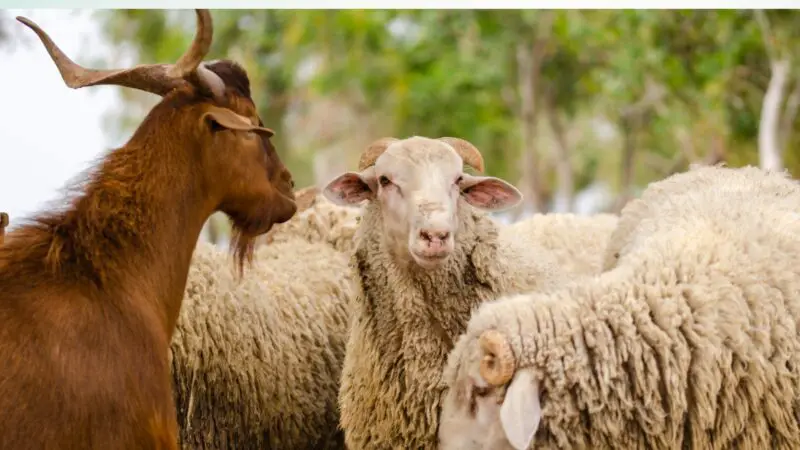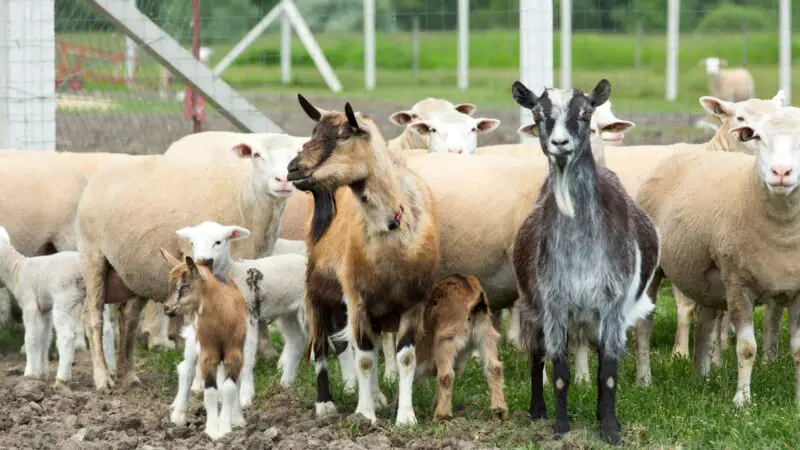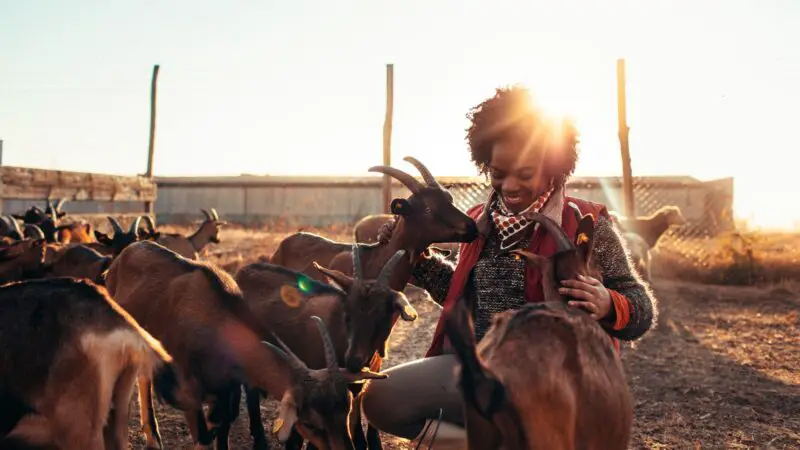Although a variety of worm parasites live in the respiratory and gastrointestinal tracts of livestock, only a few species are important clinically and economically. One such internal parasite is the Barber’s pole worm.
Barber’s pole worm is a cylindrical-shaped, reddish parasite that sucks blood from the stomach lining, mainly of goats and sheep but can also affect cattle and alpacas. This causes anemia and other clinical symptoms such as diarrhea, dehydration, and jaw swelling.
This article provides you with everything you need to know about barber’s pole worms, their appearance, life cycle, how they affect animals, signs and symptoms, and other related information. Read further for more!
What Does a Barber’s Pole Worm Look Like?
Barber’s pole worm (Haemonchus contortus) is cylindrical-shaped and takes on a generally reddish appearance due to its bloodsucking nature. It has white ovaries encircling the intestine, resembling a striped pole seen outside barber shops, hence the name. Only females have these characteristics.
Male nematodes range from 10 to 20 millimeters in length, while females are much longer, at 18 to 30 millimeters. Males have a distinctive, well-developed copulatory bursa or a bell-shaped extension found on the tail.
Both sexes have longitudinal, obliquely-arranged muscles along their body walls and a cuticle or flexible exoskeleton with outer layers made primarily of collagen and other compounds.
The Life Cycle of Barber’s Pole Worm
Dung Stage
- Infected animals will produce dung or feces containing the worm’s eggs which they will release onto pasture. Adult female worms are prolific egg producers, laying up to 10,000 eggs daily. They hatch into first-stage larvae (L1) when conditions are warm and moist.
- L1 will eventually molt to the second-stage larva (L2). Both L1 and L2 feed on bacteria found in the dung. Afterward, L2 will reach the infective larval stage (L3). It takes about 4 to 10 days for eggs to hatch and develop until it reaches L3, depending on environmental temperature.
- These larvae can remain within the feces for 5 to 7 months.
Pasture Stage
- L3 will move out of the dung pat and slowly spread onto pastures by rain and heavy dews. This is where they get ingested by animals and ultimately get infected.
- These larvae usually die within 4 months in the summer and within 6 months in winter. They do not feed and will die if no animal eats them or if they use up all their energy reserves—whichever comes first.
Host Stage
- Unsuspecting animals eat infective larvae in the pasture. Then, they develop into adults in the gut, specifically the abomasum (fourth stomach), of the infected animal where they ultimately live. Afterward, they will reproduce, females will lay eggs, and the cycle repeats.
- The time it takes from ingestion of the L3 to the time adults start laying eggs is around 12 to 21 days.
- Adult worms can live an average lifespan of 4 to 6 months inside the intestines.
Where Is Barber Pole Worm From?
It can be found in areas where climates are warm and moist such as tropical and subtropical regions, but they have adapted to live in cold, mountainous regions. Barber’s pole worms have been found in the United States, South America (Brazil), Asia (India, Indonesia), Europe (Italy, Russia), and the Netherlands.
What Animals Can Get Barber Pole Worms?

Goats and sheep are mostly affected by these parasites, but cattle and alpacas can also get them.
How Do Sheep and Goats Get Barber Pole Worms?
By ingesting the feces of infected animals while grazing in pastures. Here are some factors that contribute to the infestation of Barber’s pole worms:
- High temperatures, humidity, and rainfall in the animals’ environment
- The genetic makeup of the animals
- Frequent anthelmintic treatments annually without receiving a positive fecal sample exam and, additionally, resistance to anthelmintics due to excessive usage
- Overstocking pastures and placing way too many animals per acre
Can Humans Get Barber Pole Worm?
Humans can’t get Barber pole worms because they are intestinal parasites of ruminant animals such as sheep, goats, cattle, and alpacas.
Barber Pole Worm Infections

Barber’s pole worm can cause haemonchosis, primarily affecting goats and sheep’s productivity. It is divided into three forms depending on the severity:
- Hyperacute. This stage is rare, but it is characterized by having approximately 30,000 adult parasites in the intestine, leading to severe anemia and hemorrhagic abomasitis or the inflammation of the abomasum (fourth stomach). Animal death may occur suddenly, without even showing symptoms. Infected animals that survive will suffer severe anemia.
- Acute. Infected animals will develop anemia. Animal death may occur within 4 to 6 weeks after the initial infection. Although infected animals may present a temporary recovery, if the anemia persists and becomes severe, death will still occur.
- Long-standing. Infected animals will look anemic and show clinical signs similar to malnutrition syndromes, such as a decrease in milk and meat production. They will have reduced body weight and may die suddenly.
How Long Do Barber Pole Worms Live Without a Host?
Barber’s pole worms stay dormant in dung pats and survive for up to 4 months during the summer and up to 6 months during the winter. They die after exhausting all their energy reserves if they do not acquire a host within these periods.
Signs of Barber’s Pole Worm
In severe cases, it is important to note that Barber’s pole worm can cause sudden death without showing initial signs.
| Animal | Symptoms |
| Goats | Diarrhea, anemia, blood loss, dehydration, internal fluid accumulation (in the jaws, gut wall, thoracic cavity, and abdomen), lower growth rates, reduced reproductive performance, depression, and low energy |
| Sheep | Pale gums and inner eyelids, bottle jaws, anemia, lacks of stamina, fainting or exhaustion, weight loss, dehydration, diarrhea, rough hair coat, appetite loss, poor growth, and even sudden death |
| Cattle | Anemia, bottle jaws, weight loss, reduced growth, ill-thrift, and weakness |
| Alpacas | Lethargy, anemia, collapsing, bottle jaw, failure to gain weight, dull coat, poor growth in young animals, diarrhea, and appetite loss |
How Do You Get Rid of Barber Pole Worms?
Oral drenching is the primary measure used and recommended by experts and professionals, which involves administering chemical products to the throat or mouth of infected animals using a drench hook or drench gun. Deworming through water or feed is not recommended because the animals may get too much or too little treatment.
Best Treatment for Barber Pole Worms in Goats

The most popular chemical treatments for goats include Fenbendazole, Levamisole, Albendazole, Moxidectin, and Ivermectin.
Best Treatment for Barber Pole Worms in Sheep
Ivermectin, Tramisol, and Levamisole are among the most used chemical products to treat parasites in sheep.
How Do You Prevent Barber Pole Worms in Goats and Sheep?
1. Herd Practices
- Make sure stocking rates are low. Do not allow many animals to graze in the pasture at once.
- Provide high-quality hay, clean water, feed, and minerals to your livestock, especially when forage is unavailable or your pasture is poor.
- In the feeding area of the animals, use concrete or gravel to break the life cycle of the worms and prevent re-infestation.
2. Pasture Management
- Allow grass, shrubs, and other vegetation in the pasture to grow at least 6 inches tall, if possible, since worm larvae are typically found on the bottom 4 inches of grass.
- You can also grow plants with anthelmintic properties, such as birdsfoot trefoil, sainfoin, vetches, clovers, and chicory, which are known to reduce worm burdens in livestock due to their tannin content.
- Use the pasture for hay cutting after the animals have grazed. This helps break the life cycle of the worms and prevents re-infestation.
- Clean and maintain feeders, water, and other equipment.
3. Treatment
- Observe good nutritional management in your animals. Well-nourished animals have better chances of surviving Barber’s pole worm infestations.
- Deworm mothers as soon as they have kidded since pregnancy hormones are known to reduce the ability of these animals to fight against worm infestations.
- Monitor your herd closely and observe any behavioral and physical changes in your animals.
How Does Barber’s Pole Worm Affect Production?
Livestock affected by Barber’s pole worm will experience several symptoms, such as anemia, weakness, diarrhea, and jaw swelling, which reduces their eating habits and, consequently, their ability to produce milk, meat, and wool.
There could be up to a 38% reduction in the daily gains of infected animals weeks after the initial infection, followed by the onset of clinical symptoms.
How Do You Deworm Sheep Naturally?
Administering garlic extract can work as a natural dewormer. Other great organic options are neem oil, diatomaceous earth, composure boluses, pumpkin seeds, tobacco, ginger, and apple cider vinegar.
How Often Should You Deworm Sheep?
Sheep should be dewormed as needed. Regular deworming about every 3 to 4 weeks used to be recommended by experts; however, the animals may develop drug resistance if they are exposed to frequent deworming. The same should be done for goats.
List of Sources
Fighting the Enemy: Controlling Barber Pole Worms in Sheep and Goats
